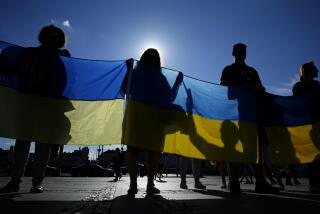At the Turning Point on Conventional Arms : Gorbachev Has Quieted His Opposition, but How It Plays in NATO Is Still the Test
- Share via
Soviet President Mikhail S. Gorbachev’s announcement of unilateral conventional-force reduction plans in his talk to the United Nations on Wednesday marks a turning point for the Soviet Union in two senses.
Internally, it signals a victory for those in and around the Soviet leadership, led by Foreign Minister Eduard A. Shevardnadze, who have been pressing for some unilateral Soviet cuts against the fierce opposition of the Soviet general staff. And externally, it poses a major new political challenge to the leaders of the Western alliance--to hammer together a negotiating position for conventional-arms talks that will not only be responsive but also protect Western interests.
Since the fall of 1987 some civilian Soviet writers have been publicly urging some force reductions on the model of Nikita S. Khrushchev’s troop cuts in the late 1950s, and since the summer of 1988 they have been publicly supported in writings by Foreign Ministry officials. In contrast, last February a deputy defense minister, Ivan M. Tretyak, vehemently denounced the Khrushchev troop cuts and warned that “any changes in our army should be considered a thousand times over before they are decided upon.”
Although no other Soviet military leader has spoken out this bluntly, virtually all of them--including the now-retired chief of the general staff, Marshal Sergei Akhromeyev--have repeatedly denounced the notion of any unilateral Soviet cuts in Europe. The general staff has claimed that despite the very large Eastern force advantage in items like tanks, the West has an offsetting advantage in ground-attack aircraft and that consequently there could be no Warsaw Pact reductions without compensating NATO reductions. The alliance denies that it has in fact any such offsetting advantage in the air.
While some in Moscow argued that unilateral Soviet reductions in Europe would “prime the pump” of Western public opinion, opening the way for Western concessions, the Soviet military apparently was adamantly opposed to giving up anything unilaterally that might otherwise eventually be traded, quid pro quo, in conventional-force negotiations. And this summer, when there was strong reason to believe that Gorbachev was seriously contemplating withdrawing some Soviet divisions from Hungary, it apparently was opposition from the military that temporarily induced him to desist.
Against this background, what happened in Moscow to break the logjam? Three factors seem most important.
First, the grievous state of the Soviet economy has become more and more evident this year to the Soviet leaders. It has become more difficult to evade the need to do something to begin to reduce the terrible price paid by the civilian economy for supporting the military Establishment.
As time went on this year, it became increasingly evident that new conventional force reduction negotiations were going to be long and drawn out. In view of the existing force imbalance, it was going to be very hard to obtain Western concessions that the general staff would consider significant. Moreover, internal NATO disagreements--notably with France--promised to further delay progress. Consequently, as matters stood, if Gorbachev wanted to extract economic benefits from reductions flowing from such talks, he might have to wait a very long time.
Finally, there has been a shift in the political balance in Moscow. The defeat of Yegor K. Ligachev in the leadership shake-up at the end of September may have helped shift the Politburo consensus to override military opposition.
In the wake of Gorbachev’s announcement, one problem now faced by the Western alliance is the time lag between word and deed. There will probably be a substantial early effect on American and European budget debates and an immediate chilling effect on alliance proposals to modernize forces. Gorbachev’s cuts will presumably materialize later.
Another problem is the considerable ambiguity in what he is promising. Gorbachev has said that by 1991 he will reduce all Soviet armed forces by 500,000 men, of which 50,000 are to be withdrawn and disbanded from Hungary, Czechoslovakia and East Germany, including six tank divisions with 5,000 tanks now in Eastern Europe. The consequences for the force balance in Europe will be significantly affected by how these cuts are distributed. The more Soviet troops and tanks are removed from the main, central front--East Germany--the more meaningful the gesture in Eastern Europe will be.
It also remains to be seen how the larger cut planned for Soviet armed forces as a whole will affect the Soviet Union’s westernmost military districts, where the Warsaw Pact reserves are stationed. Will cuts in these districts seriously affect the severe imbalance in reinforcements available to the two alliances, which is a major problem for the West because of NATO’s lack of an adequate central reserve?
The real nature of the Soviet reductions will not become apparent, however, until long after the new conventional-force negotiations have begun. Nevertheless, the prospect of some voluntary changes downward in the Soviet force posture is very welcome, and it is sure to affect the Western public’s attitude toward those coming negotiations. After Gorbachev’s speech there is likely to be increased public expectation, especially in West Germany, that some deal can eventually be worked out that would greatly reduce force levels without endangering Western security. The task now facing NATO’s leaders is to make it clear to their own people that they will seriously explore this possibility while continuing to reject any settlement that would perpetuate or worsen the existing imbalance.
More to Read
Sign up for Essential California
The most important California stories and recommendations in your inbox every morning.
You may occasionally receive promotional content from the Los Angeles Times.













